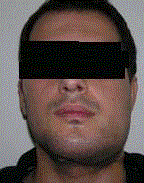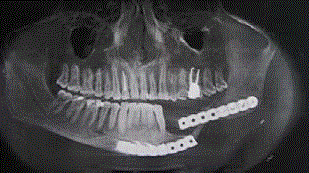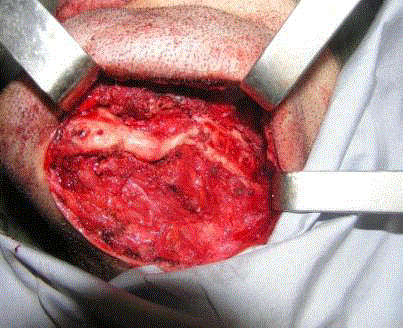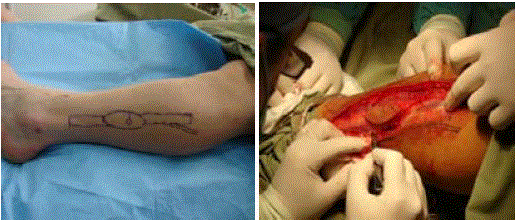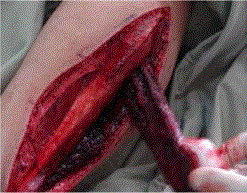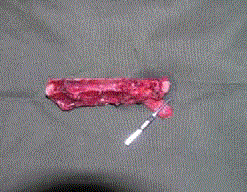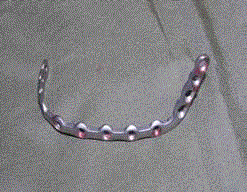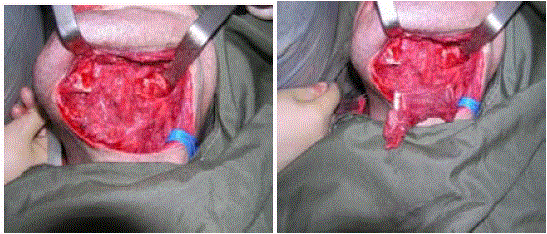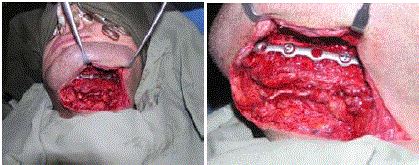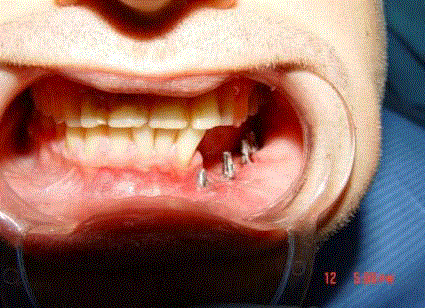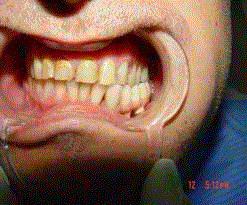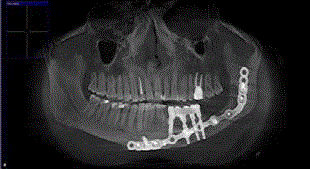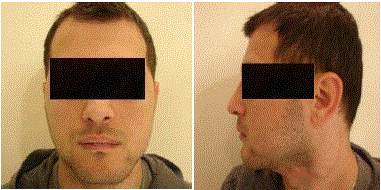Case Report
Functional Outcomes with Implant-Prosthetic Rehabilitation Following Simultaneous Mandibulectomy and Mandibular Reconstruction by Fibula Graft
Khachatryan Grigor1, Hovhannisyan Armen2, Khachatryan Levon3 and Hakobyan Gagik1*
1Department of Oral and Maxillofacial Surgery, Yerevan State Medical University after M. Heratsi, Armenia
2Department of Plastic and Reconstructive Microsurgery, Erebouni Medical Center, Armenia
3Department of Maxillofacial and Plastic Surgery, Modern Implant Medicine, Armenia
*Corresponding author: Gagik Hakobyan, Department of Oral and Maxillofacial Surgery, Yerevan State Medical University after M. Heratsi, Mailing addres: 0028 Kievyan str. 10 ap. 65 Yerevan, Armenia
Published: 06 Sep, 2018
Cite this article as: Grigor K, Armen H, Levon K, Gagik
H. Functional Outcomes with Implant-
Prosthetic Rehabilitation Following
Simultaneous Mandibulectomy and
Mandibular Reconstruction by Fibula
Graft. Clin Surg. 2018; 3: 2092.
Abstract
Aim: To evaluate the clinical outcomes and success rates of dental implant placement in vascularized
fibula bone grafts used for the reconstruction of mandibular defects.
Methods: The present study aimed at investigating the clinical treatments outcomes a 21patients (12
males and 9 females, the age was 28-63), who underwent surgical reconstruction of post-oncologic
lower jaw defects with the micro vascular fibular graft and further dental implantation between
2012-2018. The mandible was resected for ameloblastoma of the mandible 13 cases, eosinophilic
granuloma of the mandible in 2 case, odontogenic keratocysts of the mandible in 5 cases and low
differentiation osteosarcoma in of the mandible 1 cases. Flap raising and tumour resection were
always carried out simultaneously. After 5-6 months reconstruction of mandibular defects 134
implants were inserted within fibula flaps. The implants were evaluated with measures of Resonance
Frequency Analysis (RFA) during the follow-up periods using Osstell Mentor at time of implant
placement, after 3 months. The functional load on dental implants was performed with ISQ values
above 65. Dental prosthetic rehabilitation was performed after 3-4 months of submerged healing.
Postoperative clinical and radiographic controls were made regularly, the criteria for implant
success were assessed.
Results: The postoperative evolution of the patients was favorable, with the integration of the fibula
vascularized grafts. No intra-operative or immediate post-operative complications were noted and
no flap failure occurred. Free fibula flap transfer was successful in all cases. In all 21 patients, fibula
flaps provided adequate bone stock for implant placement. The mean RFA recordings of all 134
implants were 65 ISQ at implant placement respectively 73 ISQ after 3 months. Implants placed
in the reconstructed areas were demonstrated to integrate normally. Of the 134 implants placed in
these 21 patients, 4 failed to osseointegrate. Overall, graft success rate was 100% and implant success
rate was 97%.
Introduction
The treatment of jaw bone defects that result from traumatic or resective loss is one of the most actual problems in reconstructive maxillofacial surgery. The mandibular resection resulting from treatment of malignant tumors, aggressive odontogenic tumors, or trauma can cause extensive composite defects including bone, oral lining mucosa, muscles, and teeth, with a significant decrease in the patient quality of life. These defects often compromise the mastication, deglutition, speech and facial aesthetics [1]. There are various methods available for reconstruction of mandibular defects: non vascularized bone grafts, titanium reconstructive splints or microsurgical techniques that allow the use of vascularized bone. Every reconstructive technique must satisfy the following key objectives: (1) obliteration of the defect; (2) restoration of function; particularly speech and mastication; (3) structural support for reconstruction of external facial features; and (4) aesthetic reconstruction of these external facial features [2]. Fibula is the most common donor site in both the vascularized and non-vascularized groups. Simple anatomy and accessibility of the fibula caused the popularity of this transplant in reconstructions of the lower jaw [3-5]. The bone is available with enough length to reconstruct any mandible defect. A 22 to 25 centimeters segment of fibula bone may be harvested in the adult patient, permitting reconstruction of near-total mandibular defects with a single flap. During harvest, distally at least 5 cm of fibula should be left to prevent angle instability. It characteristics such as the thick and long cortical bony component (average width is 2.5 cm 3 cm, thickness approximately 1.5 cm) provide a good rigidity to withstand physiological stress during mastication. The peroneal artery and vein are usually of good quality and caliber and ideal for microsurgical anastomosis. Using a vascularized fibula bone grafts for single stage reconstruction of defects in the mandible, after resections of tumors, provides the conditions for a full rehabilitation of patients and good aesthetic results. Restoration of oral functions requires not only reconstruction of the mandibular defect, but also dental rehabilitation. The use of dental implants after transplantation of the fibula graft to restore the jaw is one of the most prospective directions in solving this problem. Dental implants allow evenly distribute the chewing load on the lower jaw and prevent the resorption of the graft [6-9]. This case report presents a combination of surgical and prosthetic solutions applied to a case of oral implant rehabilitation in post-oncologic reconstructed mandible.
Figure 1
Figure 2
Figure 3
Figure 4,5
Figure 6
Figure 7
Figure 8
Figure 9,10
Case Presentation
The 30-year-old male patient complained of pain and swelling on
the lateral mandible.
History of illness
• Was operated for osteogenic sarcoma of the lower jaw
(Stage T4N0 M0)
• the bone defect was replaced twice with free bone grafts
from iliac crest
• failure of the fixation and substitution of the bone defect
Treatment plan
• Stage I - segmentar resection of the lower jaw.
• Stage II - harvesting of the fibular graft.
• Stage III - shaping of the fibular graft and fixation of the
graft on lower jaw with the reconstruction plate.
• Stage IV - insertion of 4 dental implants 5 months after the
surgery.
• Stage V - prosthetic reconstruction 3 months after implant
surgery.
Two teams were involved in the surgery- microsurgery team and
oromaxillofacial surgeon team. Oromaxillofacial surgeons performed
the neck dissection and segmentar resection of the lower jaw, the
microsurgery team performed the flap dissection, the receptor vessels
dissection, and vascular anastomosis. After assessing the size of the
defect, the free fibular flap was harvested from the donor site following
standard protocols. The fibula was exposed and the required length of
fibula bone was harvested with a sufficient length of vascular pedicle
to facilitate the vascular anastomosis with the recipient vessels. After
segmentar resection of the lower jaw shaping and adjustment of the
graft to the recipient site and attached to the remaining mandibular
segments by fixation with titanium plate. Recipient vessels were the
facial artery and vein, with which an anastomosis of the end-to-end
type was applied. The donor site and recipient site was closed with usual
technique. The patient not received postoperative radiation therapy or
chemotherapy. Postoperative clinical and radiographic controls were
made regularly, using serial orthopantomograms and CT scan. After 5
months of healing, 4 dental implants were placed in the reconstructed
mandible. To assess the degree of osseointegration and determine
the timing of the functional load of dental implants installed in free
vascularized bone autografts, a Resonance-Frequency Analysis (RFA)
of the stability of implants using Osstell Mentor (Osstell instrument,
Integration Diagnostics AB, Gothenburg, Sweden) at time of implant
placement, after 3 months. After a healing period of 3 months second
stage surgery was performed. Upon uncover and on clinical and
radiographic evaluation, all implants were osseointegrated, abutments
were placed. The mean RFA recordings of all 4 implants were 72 ISQ
after 3 months. Dental prosthetic rehabilitation was undertaken with
a ceramometal implant- fixed prostheses. The patient was reviewed at
3, 6- and 12- month interval. All the implants were stable and in good
function with no post-operative complications. The patient had good
masticatory efficiency 3 year post-operative follow-up. The esthetic
and functional outcomes of the case restituted an acceptable quality
of life to the patient.
Figure 11,12
Figure 13
Figure 13
Intraoral view of 6 abutments in place before prosthetic
reconstruction, peri-implant soft tissues show a healthy status.
Figure 14
Figure 14
Clinical appearance after prosthetic rehabilitation with
ceramometal implant-fixed prostheses.
Figure 15
Figure 16,17
Conclusion
The reconstruction of mandibular defects following ablation for tumors with fibula-free flaps has been demonstrated to be a reliable technique with good long-term results. Implants placed in the reconstructed areas were demonstrated to integrate normally, with success and survival rates comparable to those obtained in case of implants placed in native bone. The long-term survival and success rates of implants placed in the reconstructed areas may guarantee an excellent prognosis of implant-supported prostheses. Frequencyresonance analysis method could serve as a noninvasive diagnostic tool for detecting implant stability during healing stages and subsequent routine follow ups. The method of resonance-frequency analysis allows us to determine the timing of the beginning of the prosthetic stage in each specific case.
References
- Peled M, El-Naaj IA, Lipin Y, Ardekian L. The use of free fibular flap for functional mandibular reconstruction. J Oral Maxillofac Surg. 2005;63(2):220-4.
- Peng X, Mao C, Yu G, Guo C, Huang M, Zhang Y. Maxillary reconstruction with the free fibula flap. Plast Reconstr Surg. 2005;115(6):1562-9.
- Hidalgo DA. Fibula free flap: a new method of mandible reconstruction. Plast Reconstr Surg. 1989;84(1):71-8.
- González-García R, Naval-Gías L, Rodríguez-Campo FJ. Vascularized free fibular flap for the reconstruction of mandibular defects: clinical experience in 42 cases. Oral Surg Oral Med Oral Pathol Oral Radiol Endod. 2008;106:191-202.
- Bodard AG, Bémer J, Gourmet R, Lucas R, Coroller J, Salino S, et al. Dental implants and free fibula flap: 23 patients. Rev Stomatol Chir Maxillofac. 2011;112(2):e1-4.
- Oteri G, Saverio De Ponte F, Pisano M, Cicciù M. Five years follow-up of implant-prosthetic rehabilitation on a patient after mandibular ameloblastoma removal and ridge reconstruction by fibula graft and bone distraction. Dent Res J (Isfahan). 2012;9(2):226-32.
- Kramer FJ, Dempf R, Bremer B. Efficacy of dental implants placed into fibula-free flaps for orofacial reconstruction .Clin Oral Implants Res. 2005;16(1):80-8.
- Anne-Gaelle B, Samuel S, Julie B, Renaud L, Pierre B. Dental implant placement after mandibular reconstruction by microvascular free fibula flap: current knowledge and remaining questions. Oral Oncol. 2011;47(12):1099-104.

